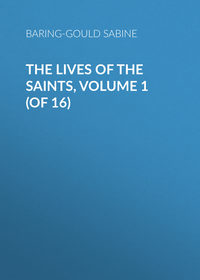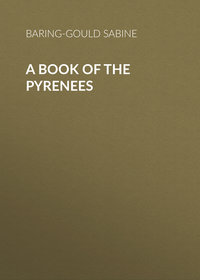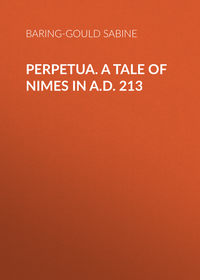 полная версия
полная версияThe Lives of the Saints, Volume II (of 16): February
There was another nun who was also smitten with passion for a young noble, and harboured in her mind the thought of escaping from her monastery, and flying to his arms. But in the night, as she slept, she saw the holy abbess, Adeloga, pass before her with a lamp in her hand, who turned and looked on her and said, "Lo, Christ cometh, prepare to meet Him. Awake, the Bridegroom cometh, go forth and trim thy light." Then she started from sleep, and was moved with compunction, and never after yielded to sensual thoughts.
Now it fell out that in after years Charles Martel was reconciled to his daughter, and endowed her monastery with lands, and visited her. Then, in the night, there stood before him, in vision, the old chaplain, who said to him, "The Eternal King hath sent me unto thee, to declare to thee my innocence in that thing whereof thou didst once accuse me. And if thou believest me not now, then will I cite thee to appear, and hear me plead my cause, before the just judgment seat of God." And when Charles awoke, he called to him his daughter, and said, "Pray for me, my dearest child, that the Lord lay not this sin to my charge, that once in wrath I spoke falsely against thee and my chaplain, thy director."
It is related that among the retainers of the abbey was a noble youth very fond of dogs, and above all, he loved one hound, which was with him in the field and forest by day, and slept at the foot of his bed at night. One day that he was in the wood, a couple of ruffians fell upon him, and murdered him for the sake of his clothes and purse, and left the body naked under the trees. For three days the faithful hound kept guard, and then it sought the abbey, and whined at the door of the lady Adeloga, and when she came forth, plucked at her dress, as though to lead her into the forest. Suspecting something was amiss, she called to her some servants, and they followed the dog to where his master lay slain. The abbess was determined to discover who were the murderers. She therefore summoned before her all the retainers and serfs on the land, and questioned them closely, but could obtain no confession. Then she solemnly warned the culprits to beware how they left the matter to the judgment of God, and she bade them, for the last time, confess. When all were silent, the hound of the murdered man was introduced, and it flew at the throats of the culprits and tore them so fearfully that one died.
The historian of the life of S. Adeloga, concludes with the following prayer. "We pray thee, most holy and gentle mother, that, as thou hast encouraged us in this life with thy good example and virtuous acts, so mayest thou deign to assist us with God in life eternal; that as we rejoice in thy commemoration on earth, so may we merit to be strengthened by thy intercession in heaven; for the sake of Christ Jesus, our Lord, who of all Saints is the reward, the glory, joy, and crown, through ages of ages, Amen."
THE HOLY MARTYRS OF EBBECKSDORF(A.D. 880.)[Authority: – The contemporary Fulda Annals of the Franks. See also the Legend in Langebek, Script. Rer. Danicarum II., pp. 57-71.]
These martyrs were Duke Bruno of Saxony, Theodoric, bishop of Minden, Marquard, bishop of Hildesheim, Erlulf of Fulda, Gosbert, bishop of Osnabrück, and many others; massacred by the Northmen.
B. PETER CAMBIAN, O. S.D., M(A.D. 1365.)[Roman Martyrology.]
This Saint was sent by the Sovereign pontiff, into the vallies inhabited by the Waldensian heretics, as Inquisitor-general in Piedmont, in 1351, and was murdered by the heretics in the Franciscan convent of Susa. The person who did the deed stabbed him in the cloister, on the feast of the Purification of Our Lady, in 1365. His tomb was opened in 1854, and the relics were elevated to the altars of several churches to which they were given. Pius IX. confirmed the devotion of the Catholics towards this martyr.
February 3
SS. Celerinus, D. C., Celerina, Ignatius, and Laurence, MM. in Africa, 3rd cent.
S. Fortunatus, M. at Rome.
S. Candidus, M. at Volaterra.
SS. Tigris and Remedius, BB., MM. at Gap, 4th cent.
S. Blaise, B. M., and Companions, at Sebaste, circ. a. d. 316.
S. Simplicius, B. of Vienne; beginning of 5th cent.
S. Anatolius, B. of Adana, in Cilicia; beginning of 5th cent.
S. Laurence the Illuminator, B. of Spoleto, circ. a. d. 576.
S. Philip, B. of Vienne, circ. a. d. 578.
S. Evantius, B. of Vienne, a. d. 586.
S. Hadelin, P. at Celles in Belgium, circ. a. d. 690.
S. Berlinda, V. at Meerbeeke in Belgium, circ. a. d. 698.
S. Werburga, V. Patroness of Chester; beginning of 8th cent.
S. Nithard, P. M. in Sweden, circ. a. d. 840.
S. Anskar, B. of Hamburg, Apostle of Sweden and Denmark, a. d. 865.
S. Liafdag, B. M. at Ripe in Denmark, circ. a. d. 980.
S. Elinand, Monk of Froidmont, near Beauvais, a. d. 1237.
SS. CELERINUS, D. C., CELERINA, IGNATIUS,AND LAURENTINUS, MM(3RD CENT.)[Roman and other Latin Martyrologies. Authorities: – The letters of S. Cyprian of Carthage, and S. Cornelius of Rome. A letter of S. Celerinus to the Confessor Lucian is inserted in some editions of the works of S. Cyprian.]
OF CELERINA, Ignatius, and Laurence nothing, except their names, is known, and even these would not have come down to us, but for their being mentioned as glorious martyrs by S. Cyprian, in a letter to their nephew, S. Celerinus. This Celerinus was first Reader, and then Deacon, in the Church of Carthage, and received orders from S. Cyprian. He was in Rome in the year 250, and confessed Christ there in the Decian persecution, spending nineteen days in chains; but to his great sorrow, his sister yielded to her fears, and was numbered among the lapsed. Afterwards Celerinus was unfortunately drawn away by Novatian into schism, but when he perceived that the schismatic sought his own advancement rather than the glory of God, he acknowledged his error, and returned to the communion of the Catholic Church.
S. FORTUNATUS, MS. Fortunatus is mentioned, together with many other martyrs, in the Roman and other Martyrologies on Feb. 2nd, as having suffered at Rome; but their Acts have not been preserved. The body of S. Fortunatus was found in 1606, in the cemetery of S. Callixtus, and was given by Pope Paul V. to the Rev. Jacobus Tirinus, S.J., for the new and beautiful Jesuit church he had built in Antwerp, in the year 1622. On account of Feb. 2nd being the Feast of the Purification, the commemoration of S. Fortunatus has been postponed in that church till Feb. 3rd.
S. BLAISE, B. M(A.D.316.)[Roman and Western Martyrologies. Commemorated by the Greeks on Feb. 11th, in some ancient Martyrologies, on Feb. 15th. The Greek Acts, of which there are four versions, are modern, and deserve little regard.]
Blasius, Blase, Blayse, Blays, or Blaise, was bishop of Sebaste, a city of Cappadocia, in the Lesser Asia. He spent a great part of his time in retirement on a hill not far from the city, whither he withdrew, after the duties of his office were finished, to be alone with God. During the persecution of the Christians in the reign of Diocletian, he lay concealed for some time in this retreat; but was at last taken and brought before Agricolaus, the governor of the province, and confessing himself a Christian, was thrown into prison. After enduring many tortures, he received the crown of martyrdom in the beginning of the fourth century. Some historians refer this event to the year 316, under the reign of Licinius. Seven holy women and two young children suffered at the same time. The Acts of his martyrdom are so untrustworthy that it is not possible to state any further particulars which are authentic. The Council of Oxford, a. d. 1222, prohibited servile labour on this day. Its observance in England was marked by several curious ceremonies. Among others a taper used to be offered at High Mass; and it was lately the custom in many parts of England to light bonfires on the hills on S. Blaise's night. Some have affirmed that these usages arose from an absurd pun on the Saint's name (sc. "blaze"); but this seems clearly erroneous, as they are not peculiar to England. In some parts of Germany, S. Blaise's Day is called "Little Candlemas Day," because of the bonfires that it was usual (for an uncertain reason) to kindle on that night. At Bradford, Yorkshire, a festival is holden every five years in memory of S. Blaise.
In the Greek paintings, S. Blaise is depicted as an old man with a pointed beard. In Western art he appears in the vestments of a bishop; his peculiar emblem is an iron comb, such as is used by wool-combers, which is said to have been an instrument of his torture. Owing, probably, to this reason, he has been esteemed the patron of manufacturers of wool, and that trade in the city of Norwich still observes his day, or did so until lately. S. Blaise is also frequently represented as surrounded by wild beasts, or birds are bringing him food; the text, Job v. 23, which occasionally accompanies these emblems, indicates that, in his case as in that of other saints, by long continuance in a solitary course of life, the denizens of the wood had become accustomed to the Saint's presence. Sometimes again, S. Blaise has a swine's head at his feet, typical of his victory over the sensual desires of the flesh. Finally, he occasionally holds in one hand, or has borne before him by a chorister, a lighted taper, typical of his being "a burning and a shining light."
S. LAURENCE THE ILLUMINATOR, B(ABOUT A.D. 576.)[The learned Bollandus, S.J., pithily remarks: "Magnas Umbria circa veterum suorum Sanctorum res gestas ortum ætatem, contraxit umbras, si non tenebras." Little is known of this Saint.]
S. Laurence the Illuminator, is said to have come from Syria with many other illustrious bishops and confessors, to Italy, in the reign of Diocletian. He was elected by the clergy bishop of Spoleto; and illumined his diocese with his teaching and miracles.
S. HADELIN, P. C(ABOUT A.D. 690.)[Martyrologies of Ado, of Wyon, Menardus, those of Liége, Cologne, &c. Authorities: – Two ancient lives, one by Notker, B. of Liége (971-1007).]
S. Hadelin was one of the disciples of S. Remacle, and when that Saint resigned his bishopric of Tongres, that he might retire from the world into the peaceful monastery of Staveloo, lately founded by S. Sigebert, King of Austrasia, he took with him the pious and humble Hadelin. On their way they rested on a bare plain, under a glaring sun, for their afternoon repose. S. Remacle remained awake, whilst his companion slept, and saw an angel bending over Hadelin, shading him with his wings from the burning heat. Remacle sent Hadelin into the neighbourhood of Dinant, on the Meuse, in 669, and finding a quiet retreat at Celles, on the Lesse, he dwelt there in a cave, and built a little chapel, on the site of which rose in after years a collegiate church. S. Hadelin is the patron of five churches in the diocese of Liége and Namur. His hermitage still exists, and from his time has never been without a pious successor. The body of the Saint was buried there, but was translated to Vise in the diocese of Liége, in 1338. His translation is commemorated on October 11th.
S. BERLINDA(ABOUT A.D. 698.)[Molanus in his addition to Usuardus, Wyon, Menardus, and Ferrarius. Authority: – An ancient life by an anonymous writer, published by Bollandus.]
Berlinda was the daughter of a nobleman named Odelard, who resided at Meerbeeke, near Ninove, in Brabant, in the reign of King Dagobert, and of Nona, his wife, the sister of S. Amandus. To a rare beauty, Berlinda joined all the gifts of intellect, but she had the misfortune to incur the anger of her father. After the death of his wife and only son, Odelard was attacked by leprosy, and lived a miserable languishing life, ministered to by his daughter.
One day that he asked her for something to drink, she filled a bowl with water, and took it to him, and then, being herself thirsty, she rinsed out the vessel, and filled it again. The father, highly offended at her doing this, drove off at once to Nivelles and offered all his lands to S. Gertrude, by the symbolic gift of a white glove and a reaping-hook and a branch of foliage. Before accomplishing his donation, he supplicated the Saint to accept his offering with her own hands. Then the reliquary, in which the holy abbess reposed, opened, and the lifeless hands of S. Gertrude were extended to receive the glove, the branch, and the sickle. Then it closed upon them.
Berlinda, being disinherited, retired to the monastery of Moorsel, near Alost, where she lived in penitence and prayer. One night she heard a choir of angels singing, as they sailed across the dark starlit sky, bearing the soul of her father to Paradise. She at once besought of the superior permission to return to Meerbeeke for a while. Her request was complied with, and she flew to her father's castle. He was dead, so Berlinda buried him in the little church he had erected there to the honour of S. Peter.
Retained by force in her paternal dwelling by the servants and tenants, Berlinda remained at Meerbeeke, where she continued her life of austerities and prayer, and died about 690, on the 3rd of February.
As no stone sarcophagus could be found in which she might be laid, a large oak was cut down and scooped out to serve as a coffin, and her body was placed in it. Numerous miracles were wrought at her tomb, so that at the end of seven years the coffin was opened, and the wood was found to have become petrified. On this occasion a church was built in her honour and that of the Blessed Virgin, and thirty years later, her relics were solemnly enshrined on May 2nd, 728. S. Berlinda has remained in great honour at Meerbeeke. She is invoked against cattle diseases; and in accordance with an ancient custom, pilgrims pray before a wooden image of the saint represented beside a cow, and touch the udder of the cow, which has become black through the innumerable touchings to which it has become subjected. According to a popular saying S. Berlinda protects trees transplanted on her festival.
S. WERBURGA, V. ABSS(BEGINNING OF 8TH CENTURY.)[English Martyrology. Authorities: – Life of Goscelin, the monk (fl. 1100), and mention in Bede, John of Brompton, Florence of Worcester, Hyden, Langherne, Simeon of Durham.]
Werburga, patroness of Chester, was born at Stone, in Staffordshire, and was the daughter of Wulfhere, King of Mercia, or the Midland English. From the lips of her sainted mother, Ermingilde, she received those first lessons of Christian truth which afterwards produced such beautiful fruit in her life.
Being one of four children, all trained under the same godly discipline, she is said to have excelled them all in virtue and discretion. Her mind was open to receive good impressions, and she listened with earnest attention to every word of instruction and advice. Thus, she "daily grew in grace, and in the knowledge of our Lord and Saviour Jesus Christ: " her mind continually expanding under the influence of holy thoughts and pure desires. At an age when most persons of her exalted position would have been found joining in the giddy whirl of pleasure, she found truest joy in contemplation of heavenly things, and holiest bliss, arising from a pure conscience chastened by fasting and sanctified by prayer. She daily assisted her mother in the performance of the whole Church Offices, and spent much time on her knees in the exercise of private devotions.
Having early resolved to devote herself to a life of virginal purity, she sought every opportunity to prepare her mind for that holy state. But she was not to overcome the world without a struggle. Temptations began to gather around her. The beauty of her person attracted a crowd of admirers, who eagerly sought her hand in marriage. Foremost among these was a prince of the West Saxons, who offered her rich gifts and made flattering proposals. She refused to accept his gifts; and to his proposals answered that she had resolved to become the bride of Christ, and wished no earthly spouse.
Another, and more violent temptation soon presented itself. Werbode, a powerful knight of her father's court, backed by the influence of her father, entreated Werburga to become his wife; but to his entreaties she turned a deaf ear. Imagining that to this refusal she was influenced by her two brothers, who were then under the instruction of S. Chad, and resolving by fair or foul means to compass his designs, Werbode sought an opportunity to murder the two brothers, and thus remove them from his path. In the accomplishment of this diabolical design, he was, to a certain extent, assisted by the father, whom he had incensed against his sons. Werbode soon after died a miserable death. The king, stung by remorse, saw reflected, as in a mirror, all the deeds of his past life, and remembered how he had promised to extirpate idolatry from his dominions, but had failed to perform his vow. With earnestness he began to atone for his faults; destroyed the idols and converted their temples into churches, built the great abbey of Peterborough, founded the priory of Stone, and in every way endeavoured to propagate the true faith among his people.
Seeing this happy change in his disposition, Werburga revealed to her father the earnest desire of her heart, and earnestly entreated his permission to consecrate herself wholly to God. At first he appeared to be very grieved, but yielding at length to her passionate entreaties, Wulfhere, attended by his whole court, conducted her with great state to the convent of Ely. Here they were met at the gates by a long procession of nuns, singing hymns of praise and thanksgiving to God. Werburga, falling on her knees, begged of the royal abbess, S. Etheldreda, that she might be received as a postulant. Having obtained her request, the voice of praise again ascended to heaven, the virgins chanting the Te Deum, as they returned to the convent. Now followed the usual trials; Werburga was first stripped of her costly apparel, her rich coronet was exchanged for a poor veil, purple and silks and gold were replaced by a rough coarse habit, and she resigned herself into the hands of her superior, henceforward to live only to Christ.
The virgin, with great fervour, now devoted herself to God. Her affections being weaned from earthly things, were fixed more firmly upon those things which are above. By prayer and fasting, by self-sacrifice and mortification, by obedience and penance, she sought to sanctify her soul and body, that she might present them, a holy and acceptable sacrifice, unto God.
After many years she was chosen, at the request of her uncle King Ethelred, to superintend all the religious houses for women in his kingdom. When she entered upon this larger sphere of duty, she laboured with earnest diligence to make all the houses under her care models of exact monastic discipline. Through the liberality of her uncle, she was enabled to found new convents at Trentham, in Gloucestershire; Hanbury, in Staffordshire; and Weedon, in Northamptonshire. These remained for several centuries as evidences of her godly zeal. The king also, at her request, founded the collegiate church of S. John the Baptist, in the suburbs of West Chester, and gave to S. Egwin the ground for the great abbey of Evesham.
S. Werburga, both by precept and example, sought to develope the religious life in those committed to her charge, and many through her influence were won from a life of dissipation and vice to a life of holiness and love.
God, in answer to continual prayers, had crowned her with many spiritual and celestial blessings. The old chroniclers say that she became the most perfect pattern of meekness, humility, patience, and purity. Her fastings and mortifications were almost incredible. She never took more than one meal during the day, and that of the coarsest food: seeking in this to emulate the lives of those fathers of the desert who shed such radiance over the Eastern and African Church. Beside the usual monastic offices, she was in the habit of reciting, upon her knees, the whole of the Psalter daily. She often remained in the church all night, bathed in tears and prostrate in prayer.
In the exercise of these holy devotions she lived to a ripe old age. Receiving at last some premonitions of her approaching departure, she made a farewell visit to all the houses under her care, and exhorted the inmates to prepare for the coming of the heavenly Bridegroom. Then retiring to the convent at Trentham, she quietly waited her departure. The messenger soon came, and found the bride ready, and so with quiet faith and perfect trust she went to the home of her Spouse, on the 3rd of February, 699.
During the reign of Henry VIII., the shrine was desecrated, and the holy relics of S. Werburga scattered abroad. What remained of the costly shrine was afterwards converted into an episcopal throne, and may still be seen, carved with the curious images of kings of Mercia, ancestors of S. Werburga, who flourished eleven centuries ago. To this day it is used as the throne of the bishops of Chester.
S. NITHARD, P. M(A.D. 840.)[From the Life of S. Anskar, c. 6; Adam of Bremen, Hist. Eccl. lib. i.]
Nithard, nephew of Bishop Gauzbert, accompanied him in his mission to the Swedes; at first he was heard with patience, but the wild pagans, enraged at his denunciation of their worship of Thorr and Odin, burst into the house where he was, and killed him.
S. ANSKAR, B.; AP. OF SWEDEN(A.D. 865.)[German, Scandinavian, and Belgian martyrologies. Authorities: – His life by his successor, S. Rembert, who was personally acquainted with him, and had shared in his mission. The following outline of the life of this illustrious saint is from the pen of the Rev. G. F. Maclear, B.D., and is extracted from his "Apostles of Mediæval Europe," somewhat curtailed, and with some modifications.]
Charlemagne was once, we are told,9 at Narbonne, when, in the midst of the banquet, some swift barks were seen putting into the harbour. The company started up, while some pronounced the crew to be Jewish, others African, others British traders, the keen eye of the great emperor discerned that they were bound on no peaceful errand. "It is not with merchandise," said he, "that yonder barks are laden; they are manned by most terrible enemies." And then he advanced to the window, and stood there a long while in tears. No one dared to ask him the cause of his grief, but at length he explained it himself. "It is not for myself," said he, "that I am weeping, or for any harm that yon barks can do to me. But truly I am pained to think that even while I am yet alive they have dared to approach this shore; and still greater is my grief when I reflect on the evils they will bring on my successors."
His words were only too truly fulfilled. The sight of those piratical banners told its own tale. The fleets he had built, the strong forts and towns he had erected at the mouths of the various rivers throughout his empire, were neglected by his successors, and what he foresaw came to pass. Year after year, during the ninth century, the children of the North burst forth from their pine forests, their creeks, their fiords, and icebound lakes, and prowled along the defenceless shores of Germany, France, and England. They laughed at the fiercest storms, landed on the most inaccessible coasts, and pushed up the shallowest rivers, while Charlemagne's degenerate successors tamely beheld the fairest towns in their dominions sacked and burnt by the terrible crews of those terrible barks.
"Take a map," writes Sir Francis Palgrave, "and colour with vermilion the provinces, districts, and shores which the Northmen visited, as the record of each invasion. The colouring will have to be repeated more than ninety times successively before you arrive at the conclusion of the Carlovingian dynasty. Furthermore, mark by the usual symbol of war, two crossed swords, the localities where battles were fought by or against the pirates; where they were defeated or triumphant, or where they pillaged, burned, destroyed; and the valleys and banks of the Elbe, Rhine, and Moselle, Scheldt, Meuse, Somme, and Seine, Loire, Garonne, and Adour, the inland Allier, and all the coasts and coastlands between estuary and estuary, and the countries between the river-streams, will appear bristling as with cheveux-de-frise. The strongly-fenced Roman cities, the venerated abbeys, and their dependent bourgades, often more flourishing and extensive than the ancient seats of government, the opulent sea-ports and trading-towns, were all equally exposed to the Danish attacks, stunned by the Northmen's approach, subjugated by their fury."10









